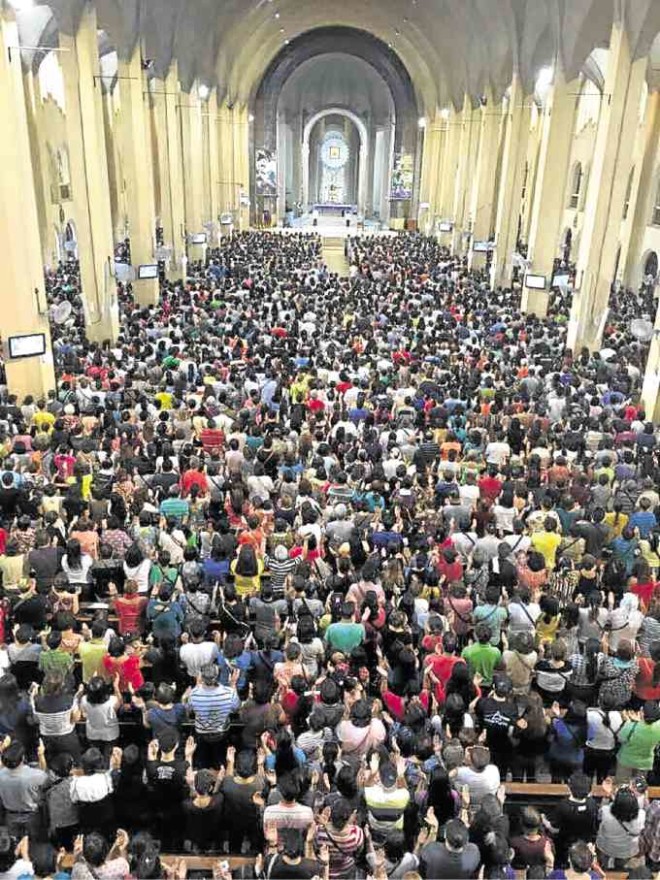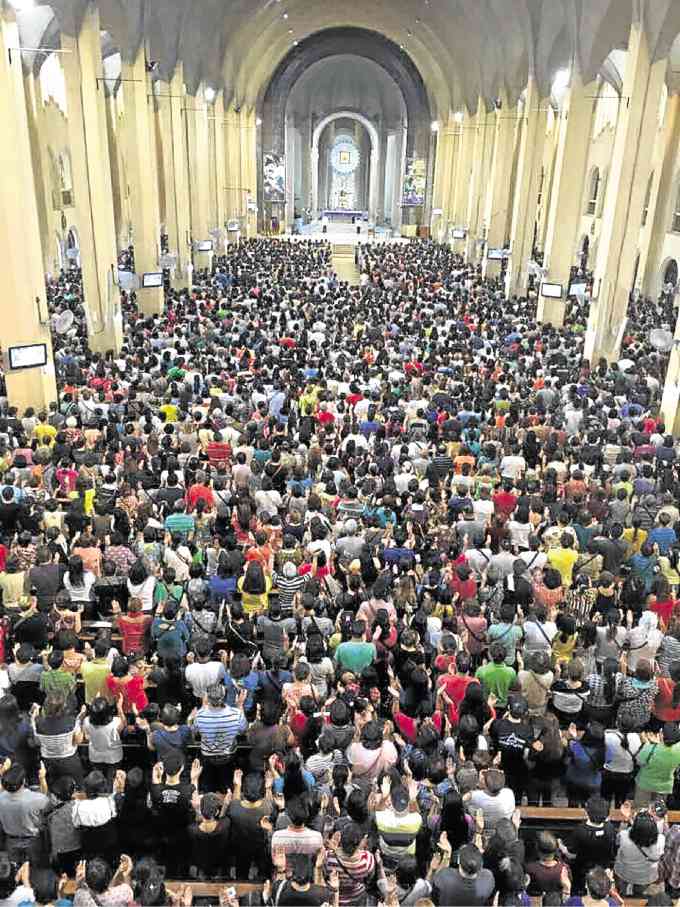
Why are millions of Filipinos attracted and drawn to the icon of Our Mother of Perpetual Help (OMPH), the image of which appears in all parish churches across the country?
What makes them join the OMPH Wednesday novena? Why do thousands of people enter the OMPH National Shrine in Baclaran every day and light candles as they seek the intervention of the Mother of Perpetual Help?
Why do some 120,000 to 150,000 people congregate in the Baclaran shrine, which is open 24 hours a day, every Wednesday? Why does this icon attract devotees coming from all classes, ethnicities, genders, ages, cultural and religious traditions?
There can only be one answer: The people find solace, comfort and compassion as they gaze at this icon of a Mother who tenderly gazes back at them. For some devotees, she is the Mother who can assist them in their various needs, from finding funds to pay for the tuition of children in school to securing a visa to be able to work abroad.
For others, she is the last resort in a desperate attempt to be healed of a debilitating illness, or to seek healing for a loved one. Others also approach her to thank her for blessings received through her interventions.
There have been other Marian devotions introduced in the Philippines since the coming of the Spanish friars in the late 1500s, to the beginning of the 20th century, hence the popularity of the devotions to Our Lady of Manaoag, Ina ng Peñafrancia, Fatima, Lourdes, Guadalupe. However, it is the devotion to OMPH, introduced in the country only in the late 1940s, that has truly caught the Filipino people’s imagination.
And yet, how many actually know the origins of this icon and how it reached the shores of this country?
To celebrate the 150th Jubilee Year of OMPH icon, the members of the Congregation of the Most Holy Redeemer (known as Redemptorist missionaries) have conducted all kinds of activities, from organizing congresses to holding missions in far-away villages across the country, to help the faithful know the icon’s origins and the meanings of its symbols.
On Dec. 11, 1865, Blessed Pius IX entrusted to Fr. Nicholas Mauron CSsR, the Superior General of the Redemptorists, this icon, exhorting all Redemptorists to “make her known to the whole world.” Since April 26, 1866, after its restoration, the icon had been placed at the altar of the St. Alphonsus Church in Via Merulana, Rome, where it holds pride of place to this day.
About 150 years later, on April 24-27, an International Congress on the OMPH icon will be conducted at OMPH National Shrine in Baclaran as the culmination of this yearlong celebration.
Historical account
But did the icon see the light of day only in 1865? No, it goes way, way back. From a historical account retrieved from the archives of the Redemptorists in Rome, we have the following data:
“There is a tradition from the 16th century that tells us about a merchant from the isle of Crete who stole a miraculous picture from one of its churches. He hid it among his wares and set out westward. It was only through Divine Providence that he survived a wild tempest and landed on solid ground. After about a year, he arrived in Rome with his stolen picture. It was there that he became mortally ill and looked for a friend to care for him. At his hour of death, he revealed his secret of the picture and begged his friend to return it to a church. His friend promised to fulfill this wish, but because his wife did not want to relinquish such a beautiful treasure, the friend also died without fulfilling the promise.”
“At last, the Blessed Virgin appeared to the 6-year-old daughter of this Roman family and told her to tell her mother and grandmother that the picture of Holy Mary of Perpetual Help should be placed in the Church of St. Matthew the Apostle, located between the basilicas of St. Mary Major and St. John Lateran.
“After many doubts and difficulties, the mother obeyed and, after consulting with the clergy in charge of the church, the picture of the Virgin was placed in St. Matthew’s on March 27, 1499. There it would be venerated during the next 300 years. Thus began the second stage of the history of the icon, and devotion to Our Mother of Perpetual Help began to spread throughout the city of Rome.”
Enormous treasure
“St. Matthew’s Church was not grand but it possessed an enormous treasure that attracted the faithful: the icon of Our Mother of Perpetual Help. From 1739 to 1798, the church and adjacent monastery were under the care of the Irish Augustinians who had been unjustly exiled from their country and used the monastery as a formation center for their Roman Province.
“In 1798, war raged in Rome and the monastery and church were almost totally destroyed. Several Augustinians remained there for a few more years but eventually they, too, had to leave. Some returned to Ireland, others to new foundations in America, while the majority moved to a nearby monastery. This last group brought with them the picture of Our Lady of Perpetual Help.
“In January 1855, the Redemptorist Missionaries purchased Villa Caserta in Rome, converting it into the general house for their missionary congregation that had spread to western Europe and North America. On this same property along the Via Merulana, were the ruins of the Church and Monastery of St. Matthew. Four months later, construction was begun on a church in honor of the Most Holy Redeemer and dedicated to Saint Alphonsus Liguori, founder of the congregation. On Dec. 24, 1855, a group of young men began their novitiate in the new house. One of them was Michael Marchi.
“He had been an altar boy serving Mass at a chapel of the Augustinians where the icon was installed. When he was already an ordained priest, he informed his confreres about this icon. Interest grew among the Redemptorists to know more about the icon and to retrieve it for their church.
“The Superior General, Father Nicholas Mauron, presented a letter to Pope Pius IX in which he petitioned the Holy See to grant them the icon of Perpetual Help, and that it be placed in the newly built Church of the Most Holy Redeemer and St. Alphonsus, which was located near the site where the old Church of St. Matthew had stood. And this is how the Redemptorists were entrusted with the icon.”
Enthralled Filipinos
The introduction of the icon in the Philippines goes back to the early 1900s. When Msgr. Thomas Augustine Hendrick was appointed to the Philippines to the See of Cebu, he immediately saw the need to have priests to look after the spiritual needs of 500,000 people of the diocese. In the wake of the exit of the Spanish friars following the Philippine Revolution, there was need for other clergy from other countries.
Passing through Ireland, Msgr. Hendrick met with the Redemptorist Superior General, Fr. Andrew Doylan CSsR, to ask him to send Redemptorists to Cebu. With the favorable response of Fr. Doylan, the first group of Irish Redemptorists to come to the Philippines took possession of the parish of Opon, in Mactan Island, Cebu, where a foundation was set up on March 17, 1906.
It was in the Opon church that the Filipinos first saw a copy of the icon who must have been enthralled by this kind of a Marian image, so different from other Marian images they had been familiar with. A novena to Our Lady of Perpetual Help began on March 17, 1907, but there were only a few devotees at the beginning.
Annual fiesta
As they moved out of Opon to other parts of Cebu to conduct missions, the Redemptorists brought the image of the icon. Eventually with more adherents to the devotion, an annual fiesta to honor OMPH began on June 23, 1907.
The Redemptorists also began to expand their mission to the north, beginning in Malate and later in Baclaran. From the 1910s to the 1940s, the Redemptorists in the Visayas had missions in Negros, Leyte, Iloilo, Samar, Bohol and northern Mindanao. Wherever they went, they introduced the icon to the people.
But the present-day formula of the popular Wednesday novena was introduced only on May 13, 1946 at the Redemptorist church in Iloilo City. This was after the war, when Catholic American soldiers were still stationed there. Being familiar with the novena in the US, they suggested to Fr. Patrick Nulty, CSsR to introduce the novena to the faithful. From a small number, those who joined reached 500 after only five months.
It then spread to the Redemptorist church in Cebu City, where the first novena took place on Sept. 15, 1946; in Lipa City on June 13, 1947; and finally in Baclaran on June 23, 1948. All novenas were translated from English to the local languages. It was in Baclaran where the Wednesday novena became greatly popular.
Byzantine style
What is it about the icon that attracts millions of Filipinos? Again, from the archives of the Redemptorists in Rome:
“This picture was painted in the Byzantine style of the Eastern Church. The purpose of this style of art is not to show a beautiful scene or person but to convey a beautiful spiritual message. Because the artist is trying to communicate something more glorious than anything in this world, the picture isn’t a realistic portrayal. A Byzantine painting is like a door. Seeing a beautiful door is nice, but who wants to just stand there looking at the door? We want to open the door and go beyond it.
“That’s how we must approach this picture. The artist, realizing that no one on earth would ever know what Mary or Jesus really looked like, and that their holiness could never be depicted in purely human terms, has portrayed their beauty and their message in symbols. What do you see when you look at this picture?
“First of all you see Mary, because she dominates the picture and because she looks straight at you—not at Jesus, not at heaven, not at the angels above her head. She looks at you as if to tell you something very important. Her eyes seem serious, even sad, but they command attention. The eight-point star on her forehead was probably added by a later artist to represent the Eastern idea that Mary is the star that leads us to Jesus. To reinforce the symbolism, there is an ornamental four-point cross to the left of the star on her forehead.
“Mary’s gaze is fixed on us, but her arms hold Jesus. In Byzantine icons, Mary is never shown without Jesus because Jesus is central to the faith. Jesus, too, is wearing the clothes of royalty. Only an Emperor could wear the green tunic, red sash and gold brocade portrayed in the picture. The Greek initials to the right of the child and his halo decorated with a cross proclaim that he is Jesus Christ.
“Jesus isn’t looking at us, or at Mary, or at the angels. Though he clings to his mother, he’s looking away, at something we can’t see—something that made him run so fast to his mother that one of his sandals has almost fallen off, something that makes him cling to her for protection and love.
Destiny
“What would frighten a little boy, even the Son of God, so much? The figures that hover on either side of Jesus and Mary—the Greek letters above them identify them as Archangels Gabriel and Michael—provide us with the answer. Rather than carrying harps or trumpets of praise, they bear the instruments of Christ’s Passion. On the left, Michael holds an urn filled with the gall that the soldiers offered to Jesus on the cross, the lance that pierced his side and the reed with the sponge. To the right, Gabriel carries the cross and four nails.
“Jesus has seen part of his destiny—the suffering and death he will undergo. Though he is God, he is human as well and afraid of this terrifying future. He has run to his mother, who holds him close in this moment of panic, the same way she will be close by his side through his life and death. While she can’t spare him his suffering, she can love and comfort him.
“So why is Mary looking so intently at us instead of her child in need? Her gaze brings us into the story, makes us part of the painting and the pain. Her gaze tells us that just as Jesus ran to his mother and found refuge, so too may we run to Mary.
“Her hand does not clasp the hands of her frightened son in a protective grip, but remains open, inviting us to put our hands in hers and join with Jesus. Mary knows there are many things in our lives that are dangerous and terrifying, and that we need someone to turn to in times of suffering and dread. She offers us the same comfort and love she gave to Jesus. She tells us to run to her as fast as Jesus did, so fast that we don’t even think about what we wear or how we go, just so we get there.”
Reverence. devotion
Today, this icon commands the reverence and devotion of all those who trek to Baclaran day or night, in rain or under the sun. Located at a most strategic part of Metro Manila, the OMPH shrine in Baclaran has had its share of significant historical and contemporary events.
St. Pope John Paul II, when he was still Krakow Archbishop Karol Josef Cardinal Wojtyla, visited and said Mass at this shrine in February 1973, five years before becoming Bishop of Rome and 263rd successor to St. Peter. When he visited the shrine again, it was eight years later when he was already the Pope.
At the height of the Edsa Revolution, on Feb. 9, 1986, the staff of Comelec walked out of their offices to protest the rigging of the elections by the late dictator, Ferdinand Marcos, and found solace inside the shrine to protect themselves from arrest. There were many Eucharistic celebrations during the martial rule years when the shrine was the site of protest movements.
Sad plight
This tradition continues to this day. In the past years, the shrine’s compound has welcomed Lumads from Mindanao who camped there as they mobilized their communities and traveled to Manila to bring to the people’s attention the sad plight of their communities and the killings of their leaders.
Today inside the shrine compound, one sees on the wall a mosaic-mural project that includes art installations—possibly the longest mosaic and mural art project in the Philippines at present. The project has been a work in progress for the last two years involving a number of artists.
Since the project started, some 3,000 volunteers have taken part in the project—church goers, devotees, college and university students, religious and many other individuals. About 30 temporary workers are direct or indirect victims of the Philippine government’s war on drugs.
The project was initiated and facilitated by Filipino artists Lorena Pacampara, Onay Antonio and Emil Yap. This work was inspired by Pope Francis’ encyclical “Laudato Si.”
With the OMPH International Congress beginning tomorrow until April 27, Baclaran can claim once again to make Our Mother of Perpetual Help known to the whole world.—CONTRIBUTED













































